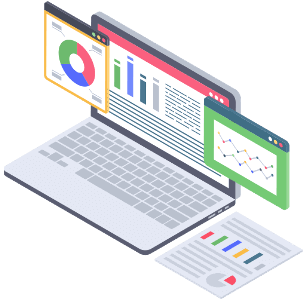 A dissertation is a significant milestone in any graduate student's academic pursuit which acts as the culmination of years of intensive research and dedication, representing the opportunity for them to make a meaningful contribution to their field of study. However, the road to dissertation completion is laden with challenges, and one of the most formidable hurdles often encountered is data analysis. To overcome this obstacle and ensure the success of their research, students can rely on affordable help and expert assistance from dissertation tutors. Data analysis lies at the heart of any dissertation, playing a pivotal role in shaping research outcomes and drawing insightful conclusions. For many students, the difficulties of analyzing and interpreting collected data can be tiresome. This is where the expertise of our dissertation tutors becomes invaluable. By offering their guidance and support, we empower students to navigate through the complexities of data analysis with confidence and clarity. In this competitive academic area, students need not grapple with data analysis in isolation. Expert dissertation data analysts bring a wealth of knowledge and experience to the table, helping students choose the most appropriate analysis approaches, utilize statistical software effectively, and validate their data accurately. Through personalized assistance, students receive tailored support that caters to their unique needs and academic background, ensuring that they can produce high-quality research that stands out in the academic community. Get to know the importance of analyzing data in dissertations and explore how expert guidance can lead to a robust and well-analyzed research outcome. By getting expert help, students can elevate their research prowess and confidently navigate the path to dissertation success.
A dissertation is a significant milestone in any graduate student's academic pursuit which acts as the culmination of years of intensive research and dedication, representing the opportunity for them to make a meaningful contribution to their field of study. However, the road to dissertation completion is laden with challenges, and one of the most formidable hurdles often encountered is data analysis. To overcome this obstacle and ensure the success of their research, students can rely on affordable help and expert assistance from dissertation tutors. Data analysis lies at the heart of any dissertation, playing a pivotal role in shaping research outcomes and drawing insightful conclusions. For many students, the difficulties of analyzing and interpreting collected data can be tiresome. This is where the expertise of our dissertation tutors becomes invaluable. By offering their guidance and support, we empower students to navigate through the complexities of data analysis with confidence and clarity. In this competitive academic area, students need not grapple with data analysis in isolation. Expert dissertation data analysts bring a wealth of knowledge and experience to the table, helping students choose the most appropriate analysis approaches, utilize statistical software effectively, and validate their data accurately. Through personalized assistance, students receive tailored support that caters to their unique needs and academic background, ensuring that they can produce high-quality research that stands out in the academic community. Get to know the importance of analyzing data in dissertations and explore how expert guidance can lead to a robust and well-analyzed research outcome. By getting expert help, students can elevate their research prowess and confidently navigate the path to dissertation success.
Expert guidance on interpreting and analyzing collected dissertation data;
- Ensure you Understand Different Data Analysis Approaches: When analyzing dissertation data, there are various approaches that students can adopt, such as qualitative, quantitative, or mixed-method analysis. Each approach has its advantages and disadvantages, depending on the research questions and the nature of the data collected. Our tutors assist students in selecting the most appropriate analysis approach based on the research objectives, ensuring that the chosen method aligns with the overall research design.
- Utilize Appropriate Statistical Software: Data analysis often involves the use of statistical software, such as SPSS, R, or Excel, to process and interpret the data, and navigating these software applications can be overwhelming for students who are not familiar with them. As dissertation tutors who provide excellent and affordable help to analyze dissertation data, we provide step-by-step guidance, helping students examine their data efficiently and accurately. Additionally, we help students interpret the output generated by these tools, enabling them to draw meaningful conclusions from the data.
- Validate Data and Ensure Reliability: Expert dissertation tutors can help students validate their data by conducting thorough checks to identify any errors or inconsistencies. This validation process helps in producing more reliable results and strengthens the overall credibility of the research findings.
- Interpret Results and Draw Conclusions: Interpreting the results of data analysis is a skill that requires a deep understanding of the research topic and the analysis approach used. Our experts possess this knowledge and can guide students in making sense of their findings. They help students connect the dots between the data and the research questions, drawing well-founded conclusions that contribute to the existing body of knowledge.
- Be Ready to Overcome Analytical Challenges: During the data analysis process, students may encounter various challenges, such as dealing with missing data, outliers, or selecting appropriate statistical tests. Our expert tutors have the experience and expertise to tackle these challenges effectively. They can introduce students to innovative techniques and strategies to overcome analytical hurdles and ensure a smooth analysis process.
- Know How to Prepare Data Visualization: Presenting data in a clear and visually appealing manner is essential to convey research findings effectively. We guide students in creating insightful data visualizations, such as graphs, charts, and tables, which aid in better understanding and interpreting the results.
For graduate students working on their dissertations, data analysis can be tough. However, with the assistance of our expert analysts, this crucial aspect of the research process becomes more manageable and productive. From selecting the appropriate analysis approach to interpreting the results, our tutors provide valuable guidance at every step of the way. By seeking our dissertation data analyzing help, students can enhance the quality of their research and improve their chances of success in completing a comprehensive and well-analyzed dissertation. With an emphasis on reproducibility, transparency, and tailored support, our expert assistance in data analysis ensures that students develop strong analytical skills that will serve them well throughout their academic and professional careers.
Get Cheap Help with Dissertation Statistical Analysis Chapter
 As the pinnacle of academic achievement, a dissertation demands meticulous research, data collection, and interpretation, making project chapter IV a crucial aspect of the entire process. However, students often find themselves grappling with complex methodologies, overwhelming data, and the need to present results coherently. At Thesis-Dissertation Writing Service, we understand the challenges students face while crafting their analysis chapter. We are dedicated to providing cheap and reliable assistance to empower students with the knowledge and skills required to conquer this essential section of their dissertation. We help to make the process from data collection to meaningful insights an enriching and rewarding experience. Study the core elements of a great analytical chapter of a dissertation. We explore the methodologies and software selection process, ensuring that students are equipped to choose the most appropriate tools for their unique research objectives. Know why conducting statistical tests is crucial, emphasizing the role they play in enhancing the credibility and objectivity of research findings. This piece addresses the best practices for organizing and presenting research results in a coherent and impactful manner. By providing valuable insights and practical tips, we help students to articulate their findings effectively, bridging the gap between data and meaningful conclusions. With our guidance, students no longer need to grapple with the complexities of statistical analysis in a dissertation.
As the pinnacle of academic achievement, a dissertation demands meticulous research, data collection, and interpretation, making project chapter IV a crucial aspect of the entire process. However, students often find themselves grappling with complex methodologies, overwhelming data, and the need to present results coherently. At Thesis-Dissertation Writing Service, we understand the challenges students face while crafting their analysis chapter. We are dedicated to providing cheap and reliable assistance to empower students with the knowledge and skills required to conquer this essential section of their dissertation. We help to make the process from data collection to meaningful insights an enriching and rewarding experience. Study the core elements of a great analytical chapter of a dissertation. We explore the methodologies and software selection process, ensuring that students are equipped to choose the most appropriate tools for their unique research objectives. Know why conducting statistical tests is crucial, emphasizing the role they play in enhancing the credibility and objectivity of research findings. This piece addresses the best practices for organizing and presenting research results in a coherent and impactful manner. By providing valuable insights and practical tips, we help students to articulate their findings effectively, bridging the gap between data and meaningful conclusions. With our guidance, students no longer need to grapple with the complexities of statistical analysis in a dissertation.
How do you know the best method and software to use in dissertation data analysis?
As you start the analysis chapter of your dissertation, choosing the appropriate method and software is crucial to ensure the accuracy and reliability of your results. Here's how you can determine the best approach for your study:
- Define your research objectives: Understanding the objectives of your research will help you identify the most suitable statistical methods and tools. Are you exploring relationships, making predictions, or comparing groups? Clearly defining your research goals will guide you in selecting the appropriate techniques.
- Review literature and consult experts: Thoroughly review relevant academic literature to see how other researchers in your field have conducted their data analysis. Alternatively, you can get cheap help with dissertation statistical analysis chapter from experts who can provide valuable insights and recommendations.
- Consider the nature of your data: The type of data you have collected (quantitative or qualitative) will impact your choice of statistical methods where Quantitative data might require parametric tests like t-tests and ANOVA, while qualitative data may be better analyzed using thematic analysis or content analysis.
- Ease of use and availability: Opt for statistical software that is user-friendly, easily accessible, and within your budget. Some popular options include SPSS, R, SAS, and Excel. Explore the features and functionalities of each program to determine which one best suits your needs, our experts can help.
- Test with a sample: Before conducting the full analysis, run a small sample of your data through different methods and software to compare results to help you identify any discrepancies and ensure the chosen method aligns with your research objectives.
Why it is advisable to run statistical tests when analyzing your dissertation data
Statistical tests are a fundamental aspect of dissertation data analysis, as they provide objective evidence and support for the conclusions drawn from your research. Statistical tests offer an unbiased way of interpreting your data. Instead of relying solely on subjective judgments, these tests allow you to make data-driven decisions, increasing the validity and credibility of your findings. Running statistical tests reduces the chances of such errors, ensuring that your results are accurate and reliable since human errors and biases can inadvertently influence the interpretation of data. These tests allow you to determine whether your data supports or rejects your research hypotheses, helping you draw meaningful conclusions. By presenting statistical evidence, you strengthen the arguments and claims made in your dissertation. This is particularly important when you need to convince the academic community of the significance of your research. This can help you draw conclusions based on the data you have collected. Statistical tests provide the rationale for your conclusions, giving readers a clear understanding of how you arrived at your results. Use appropriate statistical tests in the research in order to adhere to these requirements to demonstrate your ability to conduct rigorous research and enhance the credibility of your work.
The best way to organize and present findings in the analysis chapter of a dissertation;
This chapter is where you present the results of your statistical analysis and provide meaningful interpretations. Effectively organizing and presenting your findings can make a significant difference in how your work is perceived by readers. Here's a step-by-step guide to mastering this crucial section:
- Start with an overview: Begin the analysis chapter with a brief introduction that outlines the research questions or objectives, the data collection process, and the methods used for data analysis to set the context and prepares readers for the upcoming findings.
- Use clear and concise language: Avoid excessive jargon and technical terms and present your findings in clear and straightforward language to ensure that readers from diverse backgrounds can understand your work.
- Visualize your data: Incorporate relevant charts, graphs, and tables to present your data visually since visual representations make it easier for readers to grasp complex information and identify patterns or trends in your findings.
- Organize findings logically: Group related findings together and arrange them in a logical sequence and getting dissertation data analysis help can make it more easier. You may choose to organize your results according to research questions or themes and ensure that your findings flow smoothly and coherently throughout the chapter.
- Provide context and interpretation: Simply presenting data without interpretation can leave readers perplexed hence the need to offer insightful explanations of your findings, linking them to your research objectives and supporting literature. Discuss unexpected results and any limitations that may have affected the outcome.
- Compare with existing research: Make connections between your findings and those of previous studies and be sure to highlight areas of agreement and divergence, and explain how your results contribute to the existing body of knowledge.
- Emphasize the significance: Clearly state the implications of your findings and how they contribute to the broader field of study by articulating the practical and theoretical implications of your research to underscore its importance.
The dissertation analysis section is a pivotal element of any dissertation, demanding attention to detail and accuracy. Selecting suitable methods and software, conducting statistical tests, and organizing findings coherently are essential for a compelling analysis. By following these guidelines, researchers can bolster the validity and credibility of their work, gaining valuable insights into their data. Seeking affordable assistance from our reliable dissertation tutoring services can further enhance the quality of the analysis chapter. Embracing objective data-driven interpretations and justifying conclusions through statistical evidence ensures that the research contributes meaningfully to the academic community. A well-crafted analysis chapter not only showcases the researcher's expertise but also reinforces the importance of rigorous analysis in advancing knowledge in their field.





 We guarantee you the
We guarantee you the 